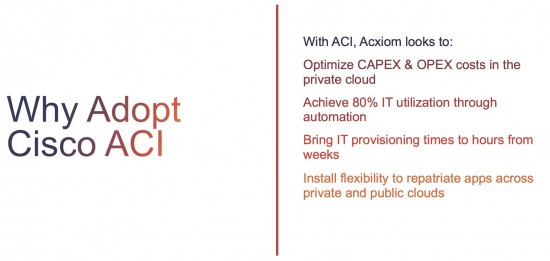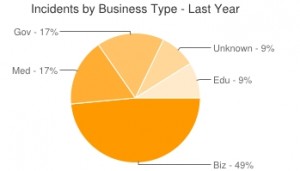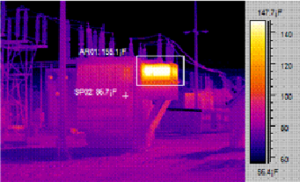Acxiom is a well-known Software-as-a-Service (SaaS) company providing data analytics and data processing solutions to Fortune 100 companies for running and analyzing their marketing campaigns. Recently Cisco spoke to Acxiom’s senior managers Kamal Kharrat, and Chuck Crane, about Cisco’s Application Centric Infrastructure (ACI) strategy and how it helps them address their Data Center challenges. In this blog, I will present a brief summary of our discussions. Acxiom is experiencing exponential growth in its customer base, running millions of transactions every week in their hybrid-cloud based data centers. But this growth has brought in its wake several challenges. Acxiom stores confidential, compliance driven data in their private data center infrastructure, and is currently facing elastic scalability problems. Second, they want to transition from a high CAPEX, fixed infrastructure utilization model towards a dynamic model, in which workloads can be seamlessly moved across the private and public infrastructures. Besides, Axciom has a heteregenous mix of L4-L7 vendor devices, multi-hypervisor and security systems and has a pressing need for an open, policy based extensible foundation for their AOS SAAS to bring these services together.

Acxiom is excited to consider Cisco ACI as the best solution to address these problems and are looking to automate their compute, storage and security infrastructure provisioning and achieve the elasticity requirements in their private cloud similar to what they are achieving in the public cloud. Also, Acxiom plans to move the workloads in and out of compute and storage platforms while changing the security zones on-demand increasing the resource utilization to upwards of 80%. Mr. Chuck Crane is quick to point out that Acxiom makes more than 20,000 network and security configuration changes every year and feels the only way to keep up with the growing customer base is to eliminate the labor intensive man-hours and costs that go with them, and hopes to achieve significant reduction in these inefficient processes via automation. He says ACI is the key to arm the network operations to automate the operations and ultimately attain the competitive advantage of agile IT resulting in faster time to market and capitalizing new revenue opportunities.
Today, depending on the solution, it takes about 7 days to 3 weeks for a full provisioning of the resources and the goal is to bring the provisioning time down to hours. With ACI, they say, Acxiom aims to achieve 24-hour turnaround in end-end infrastructure provisioning for application deployments Acxiom will realize a significant reduction in OPEX with this automation.

Last, let us look at how ACI’s Openness helps Acxiom’s data center operations. When looking at repatriating an application (Figure 2) into a private data center, one of the critical challenges is the ability to port the same tools and automation from the public to the private cloud and the network infrastructure is a critical layer in realizing this goal. The open standards based ACI helps Acxiom to use their existing tools and expertise in working across public and private clouds in building infrastructure quickly and achieving the business goals of faster time to market resulting in increased revenue potential.
In conclusion, the Acxiom executives assert that ACI allows their private datacenters to integrate best of breed technologies with their existing infrastructure and achieve full automation seamlessly using service stitching from compute through load balancing through the security platforms – all from a single point of control. This helps Acxiom to optimize costs, reduce turnaround times and at the same time work seamlessly across private and public clouds.
Related:
Acxiom Executives share customer insights on Application Centric Infrastructure (video)
The Promise of an Application Centric Infrastructure (ACI)
The Dynamic Security Model of Cisco ACI (video)
New Applications Are Knocking: Is your Data Center OPEN for Business? (video)






 By Leonard Luna, Senior Marketing Manager, Cisco Service Provider Solutions
By Leonard Luna, Senior Marketing Manager, Cisco Service Provider Solutions
CONNECT WITH US